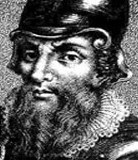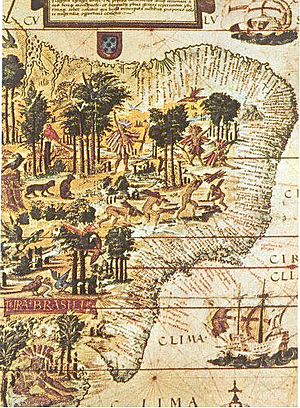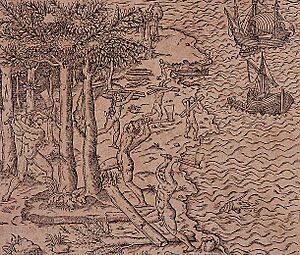Fernão de Loronha facts for kids
Fernão de Loronha (born around 1470, died around 1540) was an important Portuguese merchant. His name is sometimes changed to Fernando de Noronha. He was from a Jewish family in Lisbon, Portugal.
Fernão de Loronha was the first person to hold a special agreement (a charter) to trade in Brazil. This was from 1502 to 1512. He was also the first "donatary captain" in Brazil. This meant he was given land to manage for the king. He helped pay for many early Portuguese trips across the seas. The islands of Fernando de Noronha near Brazil are named after him. One of his expeditions found these islands. The king gave them to Loronha and his family in 1504.
Contents
Fernão de Loronha's Life
Early Life and Connections
Fernão de Loronha was a Sephardi Jew who became a Catholic. People who converted from Judaism to Catholicism in Portugal were called cristão-novo. His father and brother were also important people. They were given special titles and a family symbol (coat of arms). Fernão de Loronha married a woman named Violante Rodrigues.
By the year 1500, Fernão de Loronha was a successful merchant in Lisbon. He worked as an agent (called a factor) for Jakob Fugger. Fugger was the head of a very rich German banking family. In 1504, King Manuel I of Portugal called Loronha a "knight of our house." This shows that Loronha had strong connections. It was a time when many wealthy Jewish people faced difficulties in Portugal.
Exploring Brazil and Brazilwood
After Pedro Álvares Cabral found Brazil in 1500, Portugal sent more ships. These ships explored the Brazilian coast in 1501. The leader of this trip is not known. But Amerigo Vespucci was on board and wrote about it. Some historians think Fernão de Loronha might have led this trip. Others believe he only provided the money for it. They think he was too busy to go himself.
The 1501 trip explored much of Brazil's eastern coast. They named many places along the way. When they returned to Lisbon in 1502, they reported a big discovery. There was a lot of brazilwood (pau-brasil) on the coast. Brazilwood was very valuable in Europe. It made a deep red dye for clothes. Before this, it had to be brought from India at a high cost.
Loronha saw a chance to make money from this new discovery. He gathered a group of Lisbon merchants. He led this group and asked the king for permission to use the brazilwood. In September 1502, King Manuel gave Fernão de Loronha a special agreement. This agreement gave him the only right to trade in Brazil for three years. Brazil was then known as the "Lands of Vera Cruz."
In return, Loronha had to send six ships each year. He also had to explore new coastlines. He needed to build a fort in the new land. Loronha also had to share some of his profits with the king. He paid nothing the first year. Then one-sixth in the second year, and one-quarter in the third. Some records say he had a ten-year agreement. For this, he paid the king a fixed amount of money each year. This might have been a new deal made in 1505.
Setting Up Trading Posts
In 1503, Loronha's group sent a new trip of six ships. Gonçalo Coelho was the captain, and Amerigo Vespucci joined again. Their job was to explore the coast and set up places to collect brazilwood. On August 10, 1503, they found an island. It was off the northeast coast of Brazil. Today, it is called Fernando de Noronha island.
Loronha told the Coelho-Vespucci trip to build feitorias. These were like warehouses. They were places to gather the brazilwood. It is thought that three warehouses were built. One was at Cabo Frio, another at Porto Seguro. A third was probably in Guanabara Bay. Later, around 1509 or 1511, another trip set up a brazilwood warehouse. This was at Baía de Todos os Santos (modern Bahia).
On January 14, 1504, King Manuel gave the island of São João (Fernando de Noronha) to Fernão de Loronha. This made Loronha the first person to own land in Brazil from the king. A warehouse was quickly built on the island. It became the main center for Loronha's business. Brazilwood was collected there. Then it was sent on larger ships back to Portugal.
By 1506, Loronha's group had collected a lot of brazilwood. They made a huge profit from it. Loronha also traded in other things. These included colorful Brazilian parrots and monkeys. He also traded cotton and sometimes, Indian slaves.
Loronha's business did not use force. Brazilwood was bought from local people. Brazilian Indians (mostly Tupi) cut the wood. They brought it to the warehouses. There, they traded with Loronha's agents. They received iron goods, tools, knives, and mirrors. Slaves were not taken by force. They were bought from local tribes who had captured them in wars.
End of the Charter
Loronha's trading agreement was renewed in 1506. It was renewed again until 1512. After that, the king gave the agreement to a different group of merchants. In 1515, the Portuguese king took over the brazilwood trade himself.
By this time, Spanish and French traders had started visiting the Brazilian coast. They would take brazilwood or steal from the Portuguese warehouses. These warehouses had few guards. Portuguese merchants could not stop these foreign traders. So, the king decided to take control. He set up a military patrol to protect the coast. Even though Loronha lost his trading agreement, his family kept the island of Fernando de Noronha. His family owned it until at least 1580.
Fernão de Loronha also helped prepare ships for trips to India. One of his ships, the Judia ("Jewess"), found an island in 1506. This island is now called Bassas da India. Its name comes from a mistake in the original name.
How Brazil Got Its Name
The Land of Brazil
Fernão de Loronha played a big part in how Brazil got its name. The land was first officially called "Vera Cruz" or "Santa Cruz." But during Loronha's time, people started calling it "Terra do Brasil." This means "Land of Brazil." The people living there became known as Brasileiros.
It was common in the 15th and 16th centuries to name lands after their main product. For example, the Madeira Islands were named after wood. The Pepper Coast was named after pepper. The "Land of Vera Cruz" became known as the "Land of Brazil" for the same reason. Some old letters even called it "Land of Parrots."
The Name for People from Brazil
The name for people from Brazil is interesting. In Portuguese, a person from Brazil is called a Brasileiro. But the ending -eiro usually means a job or occupation. For example, a carpenter is carpinteiro. The ending for people from a place is usually -ano. So, a person from Brazil should have been called a Brasiliano.
But Brasileiro stuck. This is because during Loronha's time, brasileiro meant a person who cut or traded brazilwood. This job name slowly became the name for all the people living in the land.
See also
 In Spanish: Fernando de Noronha (explorador) para niños
In Spanish: Fernando de Noronha (explorador) para niños




